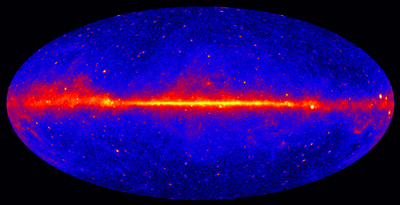LAT All-Sky Survey Observations
The Fermi observatory operates primarily in an all-sky scanning survey mode that maximizes observing time while maintaining excellent uniformity. This means that the LAT rarely stares at a single point in the sky. Rather, the boresight of the LAT continuously scans the sky, alternating between the northern and southern hemispheres each orbit. This strategy makes the best use of the LAT's large 70 degree half-angle field of view, and provides 30 minutes of livetime on each point in the sky every two orbits (approximately three hours).
instrument on NASA's Fermi Gamma-ray Space Telescope. Brighter colors indicate brighter gamma-ray sources.
Image Credit: NASA/DOE/Fermi LAT Collaboration
Fermi's survey observations are regularly interrupted during passages through the South Atlantic Anomaly, a region of high particle flux, where the instruments cease data-taking and are commanded into a protected state. This interruption, which primarily affects observations while the observatory is in the southern portion of its orbit, results in an exposure differential between north and south of ~15%. In addition, sky-survey is interrupted by the occasional Autonomous Repoint Request (ARR) of the observatory to observe gamma-ray bursts deemed to be "of-interest" by algorithms running in the instruments' flight software. Finally, on rare occasions, the planned survey mode may be halted to allow a Target of Opportunity (ToO) observation of a particularly interesting astrophysical event. Details of the Fermi ToO observations can be found here. Please note that as of early 2018, both ARRs and ToOs have not been possible as a result of the -Y SADA Anomaly (see link for details).
Observatory Sky-Survey Profiles
Listed below are the sky-survey profiles that have been used on Fermi since the start of the nominal mission on August 4, 2008. The file defining the profile is linked to each profile name. Each profile consists of a sequence of 17 entries giving a time (in seconds) and the corresponding angle (in degrees) at which the LAT boresight is rocked north or south of the orbit plane. The profile must start and end at zero degrees. Typically, a profile runs for two orbits, with the observatory rocked to the north for the first orbit, and to the south for the second. However, other cadence profiles have been performed (e.g. the 3 orbit profile test shown below). The effective dates and times for each profile are provided.
| Profile Name | Duration | Start Date/Time | End Date/Time |
|---|---|---|---|
| 35-deg Sky Survey (v1) | 11474 sec | 2008-08-04 00:00:00 | 2008-08-05 12:00:00 |
| 35-deg Sky Survey 3-orbit test | 17217 sec | 2008-08-05 12:00:00 | 2009-08-07 00:00:00 |
| 35-deg Sky Survey (v2) | 11478 sec | 2008-08-07 00:00:00 | 2009-03-24 14:00:00 |
| 40-deg Sky Survey test period | 11478 sec | 2009-03-24 14:09:23 | 2009-03-26 14:00:00 |
| 35-deg Sky Survey resumes | 11478 sec | 2009-03-26 14:00:00 | 2009-05-07 00:00:00 |
| 39-deg Sky Survey test period | 11478 sec | 2009-05-07 00:00:00 | 2009-05-21 00:00:00 |
| 35-deg Sky Survey resumes | 11478 sec | 2009-05-21 00:00:00 | 2009-07-09 00:00:00 |
| 39-deg Sky Survey | 11478 sec | 2009-07-09 00:00:00 | 2009-09-03 00:00:00 |
| 50-deg Sky Survey (v1) | 11478 sec | 2009-09-03 00:00:00 | 2010-04-29 00:00:00 |
| 45-deg Sky Survey test period | 11478 sec | 2010-04-29 00:00:00 | 2010-05-27 00:00:00 |
| 50-deg Sky Survey (v2) | 11478 sec | 2010-05-27 00:00:00 | 2010-12-27 15:36:57 |
| 50-deg Sky Survey (v3 - 3 orbits) | 17217 sec | 2010-12-27 15:36:57 | 2011-01-06 00:00:00 |
| 50-deg Sky Survey (v2) | 11478 sec | 2011-01-06 00:00:00 | 2011-12-22 00:00:00 |
| 50-deg Sky Survey (v4) | 11466 sec | 2011-12-22 00:00:00 | 2013-9-19 00:00:00 |
| 50-deg Sky Survey (v5) | 11454 sec | 2013-9-19 00:00:00 | 2019-2-14 00:00:00 |
| 50-deg fixed Sky Survey (v1) | 11430 sec | 2019-4-1 00:00:00 | 2019-2-14 00:00:00 |
| 50-deg Sky Survey (v6) | 11426 sec | 2019-2-14 00:00:00 | 2022-5-13 00:00:00 |
| 50/60-deg Sky Survey (v1) | 11426 sec | 2019-2-14 00:00:00 | 2022-5-10 00:00:00 |
| 50-deg Sine Sky Survey (v1) | 5713 sec | 2019-2-14 00:00:00 | 2022-7-22 00:00:00 |
| 50/60-deg Sky Survey (v2) | 11420 sec | 2022-5-10 00:00:00 | 2023-2-16 00:00:00 |
| 50-deg Sky Survey (v7) | 11420 sec | 2022-5-13 00:00:00 | 2023-2-02 00:00:00 |
| 50-deg Sine Sky Survey (v2) | 5710 sec | 2022-7-22 00:00:00 | 2023-2-16 00:00:00 |
| 50/60-deg Sky Survey (v3) | 11412 sec | 2023-2-16 00:00:00 | 2023-4-07 00:00:00 |
| 50-deg Sky Survey (v8) | 11412 sec | 2023-2-02 00:00:00 | 2023-4-14 00:00:00 |
| 50-deg Sine Sky Survey (v3) | 5706 sec | 2023-2-16 00:00:00 | 2023-7-26 03:29:00 |
| 50/60-deg Sky Survey (v4) | 11408 sec | 2023-4-07 00:00:00 | 2023-7-23 23:30:00 |
| 50-deg Sky Survey (v9) | 11408 sec | 2023-4-14 00:00:00 | 2023-7-13 01:56:00 |
| 50-deg Sine Sky Survey (v4) | 5700 sec | 2023-7-26 03:29:00 | TBD |
| 50/60-deg Sky Survey (v5) | 11400 sec | 2023-7-23 23:30:00 | TBD |
| 50-deg Sky Survey (v10) | 11400 sec | 2023-7-13 01:56:00 | TBD |
Last updated by: Joseph Eggen 07/05/2023




